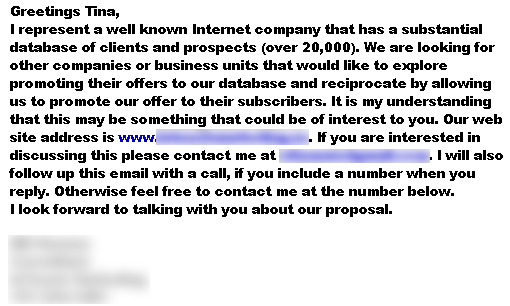15 Tips for Writing Effective Email
 Photo by
Lucia Holm
Photo by
Lucia Holm
Have you ever needed to email someone – a stranger, asking them for a favor? How can one compose email such that they will be read and responded to? How do we effectively email someone who gets a lot of email?
Whether personal or business, the ability to compose efficient and effective email is super useful – both in terms of productivity and responsiveness.
We’re all busy, and we’ve all received long, ambiguous and rambling email. Ironically, most of us have also been guilty of writing such verbose email while requesting for someone else’s time.
Now that I’ve had a little taste, on the receiving end of such email, it quickly became obvious which kind of email works and which do not. I have made some interesting and useful observations on effective email – particularly,
- What not to do when emailing someone (ie. a stranger).
- How to write email that people will actually (want to) read.
The point of this article is to share tips on how to approach people via email in the most efficient way possible, along with some common pitfalls on why some emails do not work.
Assumptions
Before we dive in, let’s lay out some assumptions:
- The recipient (person you are emailing) potentially gets a lot of email
- You need something from the recipient and plan on pitching it via email
- You either do not know the recipient, or she is an acquaintance, or she is a close friend and you’re asking for an unusual request.
Our goal is to construct email that:
- Will actually be read
- Will actually be understood
- Will not annoy the receiver
- Does not take up too much time on the receiver’s end.
Email Psychology
Generally speaking, the sender and receiver see things from drastically different points of views. And from the perspective of a sender, we often do not spend time understanding who the receiver is and what their inbox might look like. Let’s have a quick glance at both sides:
Observing the Receiver
- Gets a lot of email.
- May receive compliments regularly, if they are a public figure.
- Regularly gets asked a standard set of questions and favors.
- Does not have a lot of free time.
- Does not mind helping you, if it is fast.
Observing the Sender
- Spends a long time crafting the ‘perfect’ (-ly long) email.
- Believes that their request is original, unique, and special.
- Believes that they are the first to ask for such favors.
- Cannot imagine why anyone would turn them away.
- Desires to tell the whole story, explained from every angle, so that the listener can understand their point of view.
With such divergent perspectives, it’s no wonder receivers receive the kinds of email that they do, and that senders are wondering why their emails isn’t effective or eagerly responded to.
Now, putting ourselves in the perspective of a receiver (and we’ve all been there). When we are faced with going through an inbox full of email – coming back from a vacation for example, we have some natural habits that are worth noting:
- We tend to answer, or be drawn to email that are the fastest to answer or process. That means email that require very little work or thought.
- When we open an email that’s very long, our gut reaction is to close the email, or come back to it later when we might have more time.
- When we receive an email from someone wanting something from us, wanting us to buy something, or wanting our time, we instantly feel guarded and will automatically want to say no, even if the offer will benefit us in reality.
- We go through email while asking “what’s the point?”
- We go through email that is pitching something while asking “why should I care?”
15 Tips for Composing Clear, Concise & Responsive Emails

1. Determine Your Desired Outcome
Most people know roughly what they want, but do not take the time to clearly think it through. This is how we end up with ambiguous or rambling email. Without a clear understanding of our desired end results, our thoughts are disorganized and we can easily confuse the receiver.
There are 4 types of email:
- Self Fulfilling Email – The email itself is the point. You want to tell the receiver something, either a compliment or information. No reply is necessary.
- Inquiries – You need something from the receiver in the form of a reply. For example, advice, or questions answered. The reply is your desired outcome.
- Open-Ended Dialog – to keep communication lines open, for the purpose of some future result or benefit.
- Action Emails – The goal is not the reply, but some action on the part of the receiver. For example, a sales pitch, or asking for a website link exchange.
Which type of email are you sending? What is your desired outcome?
The clearer your intention, the more focused you will be, the better you can cater email for the intended result, the more likely you will get your desired outcome.
2. Quickly Answers, “What’s the Point?”
People want to know “what do you need from me?” Answer this question quickly. Skip long introductions, backgrounds, compliments and details. Jump to the point. State it clearly using minimal words.
If action is needed, make it clear what the desired action is from the recipient.
And if no action or reply is expected, say that! “No reply necessary.” It’ll be like music to their ears.
3. State Benefits Clearly
If a pitch is presented, make sure it includes many clearly stated, easily understood benefits for the receiver.
Too many pitchy emails focus solely on the sender and why the action will benefit the sender. If you don’t present incentives, or they are difficult to understand, the receiver will say no – resulting in a waste of time for both.
Also, make sure the incentives are realistic, the exchange is fair, and there truly are benefits to the receiver. Do your homework before contacting someone. Put yourself in their shoes, “Would you act on the offer?”
Example, emailing a high profile website like lifehacker for a link exchange is not a fair exchange. It’s called spam. If they don’t display links to other sites, likely they won’t display yours.
4. Remember to KISS
KISS = Keep it simple, stupid (I didn’t come up with this)
When we send out a long email asking for something from the receiver (time, favor, etc), we are essentially saying “I do not respect your time.” Show them you appreciate their time, by making email short, and simple to answer.
Using as few words as possible, introduce who you are, context if necessary, and why you are emailing.
Being brief doesn’t mean we have to be boring. We can be creative with our wording, add a dash of personality where you see fit, but still be brief.
5. Save the Whole Story – Stick to the Facts.
People tend to say too much in email. We feel compelled to describe all the details and disclose the whole of our existence so that the receiver can understand the whole picture. Truth is, unless you already know this person well, they really don’t care.
Unless asked, you don’t need to overly elaborate anything. Simply stick to the facts – it’ll help you keep your message short.
6. Pretend Face-to-face Intro
If you just met someone new at a party, would you open your mouth first and give them a rambling story about your life? Probably not. Typically, we close our mouth after a quick intro. In email, stopping talking is equivalent to hitting the send button.
Treating email introductions as if you are meeting them in person is another trick to keeping messages short.
7. Text Message Trick
When we are on mobile devices like the blackberry or our cell phones, we lack the fluidity of the computer keyboard, and as such, we get to the point really fast.
Now, pretend you’re on a mobile device, what would your message be now?
8. Avoid Excessive Compliments
Some people have the idea that the more compliments they throw out, the more likely the receiver will comply with their offer/need/pitch.
There is a difference between being genuine and saying what’s on your heart, and going out of your way to compliment someone. We humans are exceptional at detecting unauthentic phrasings and remarks – even in email.
Compliment only if you really mean it. And remember to be brief if you need action from the receiver.
9. Be Personal and Personable
Personalize email with relevant remarks to the receiver, put in a quick comment about their site, product or work. Address the person by name, sign email with your own name, and a friendly comment like “Enjoy your weekend!”
10. Make it Easy to Be Found
In your signature, include appropriate URLs for your website, blog, portfolio or product. Make sure the links are functional so they can read more about you in one-click.
11. Use Simple English
When the writing is too formal or uses irrelevant technical lingo, it is difficult for laymen to understand. Plus, you come off sounding like a legal document or spammer. Neither is good.
Write like you talk, using conversational English. Be authentic and realistic.
Trying to sound professional will come off as if you are trying to sound professional. Use your real voice – it’s more endearing and approachable.
12. Font Matters
There is nothing worse than opening an email and become blinded by the brightness elicited by all the words displaying in bold. It makes me want to instantly close the email for the sake of protecting my eyes.
Alternatively, fonts that are too small, too large, or otherwise hard to read (ie. 8 point, times roman font, all bold.) makes us not want to read the email as well.
Beware of your fonts in your ‘presentation’. Do not bold the entire email, use easy to read fonts (ie. Arial), and use a standard size. Do not use extravagant colors since they don’t work well on all monitors and can be hard to read.
13. Formatting Matters
Make emails easy to read and quick to scan by using bullet points, numbered lists, and keeping paragraphs short. Highlight keywords (bold or italic) for emphasis, without overdoing it.
14. Minimize Questions
Ask questions that matter, and limit the number of questions and favors you ask in an email (one or two max). The more questions (especially open-ended ones) asked in one sitting, the less likely you are to get a response, and the less likely all your questions will be answered.
Also, ask specific questions instead of a general open-ended ones. Be reasonable and thoughtful when asking. Don’t expect the recipient to solve all our life problems. For example, “How can I get rich quick? How can I become successful?” are too broad. Break them down into specifics and ask the one question that really matters.
You can send additional questions in separate emails. Key is in keeping the line of communication open by not overwhelming the receiver.
15. Trimming of Words
Like grooming a garden, read through the finished email and trim out words, sentences, and paragraphs that do not contribute towards your desired result.
Check for potential ambiguities and unclear thinking. Can you rephrase sentences for clarity using fewer words? Check for excess commentary that doesn’t add to the email’s main point. Remove extra details disclosed, unnecessarily.
Case Study:
This morning, I received this little gem in my inbox (bold and everything):
Subject: We Are Looking For Offers For Our Database

My first instinctive reaction was “What the *bleep*?” I actually stopped reading the moment the email flashed open, because my eyes hurt from the brightness of the bold fonts. My follow up questions were: What do you need from me? What the heck are you selling? Why should I care?
After reading it about five times, I’m still left confused as to what they do, or what action items I can take – aside from giving up my phone number (which I would never do).
Reviewing our 15 tips above, a more effective email might be:
Subject: Opportunity for Free Traffic
Hi Tina,
I’m writing on behalf of <web-url>. We make it easy for bloggers to network with one another.
Our site gets X monthly page views, just having your website listed in our network will expose it to many new readers.
Here are some websites currently in our community: <list of related and well known websites>.
Joining takes less than 5 minutes and you’ll love the results: <web-url>Let me know if you have any questions.
<name>
<company name>
<site url>
Take Home Points:
- No rambling stories or long intros.
- Get to the point quickly.
- Next action clearly stated.
- Present benefits.
- Fonts and formatting matter.
- Review for conciseness, simplicity and clarity.
- One question per email.
- Be yourself – that is, the concise version of yourself.
* What types of email annoy you, as a receiver? What tips do you have for keeping email efficient? Got ideas for writing ‘pitch’ emails? Share your thoughts and ideas in the comment section. See you there!













Hey guys
Can u people let me know some tips to write the effective mails in official matters. like writing the mails to manager , clients , hr people etc.
Hello Tina! Thank you for the fantastic tips, I especially liked your case study; I’ll sure use the remade email example as an inspirational template.
Great tips and very clear example! I like the suggestion to treat email communication like a text message – keep the message simple and focused.
Bhushan
Hi Tina,
Thanks for e-mailling tips. God bless you.
Tina,
“Your Observing the Sender” points are applied to me and I feel ashamed of myself. Thanks a lot. I was struggling writing emails and in clean and crisp communication. If you observe closely, your few points are applicable for day to day professional conversations too. Keep it to the point and hit the bottom line.
Thanks again,
Swapnil.
Best link on the planet about email writing tips
I’m a little annoyed when I get lengthy e-mails that have very excessive and useless padding: “Hi there and a very very excellent morning to you dear, my first name is Kawry. I’m just e-mailing you today due to the fact that I have been wanting to ask you today that how are you doing today? If you don’t mind answering that question that is of course. You’re not forced to answer just to let you know (not trying to be rude or anything, just saying incase you didn’t know). Of course, you can take as much time as you want I am not rushing you (not implying I am though, just incase it was a bit rude). Okay, now I’m not slacking (I don’t mean to say that I usually slack at all though), off to the next paragraph!
…
etc.”
In one paragraph I am told “Hi I’m Kawry, how are you doing today friend?”
I can take some padding/disclaimers as I know they all mean well, provided it’s genuine and not deliberately done to increase the message size to prove something.
Thank you for giving such practicals tips. The example was an eye opener. It’s extremely helpful and made me reflect on my actions.
Thank you.
hi tina,
its so nice email.i think first time in my life i am watching this type of practical practicing email .its very special tips for learner email.
thanks again
zahid khan
Rule #0
You also always want to put replies at the *bottom* of the email – not on top. Many email clients screw this up by putting the cursor on the top.
Don’t be that person though. Emails are better with bottom posting.
Great post! I have found 7, 11, 12, and 13 to be very important when sending emails to people, especially to people I don’t know (potential employers, job applications, people at other organizations). People don’t have a lot of time and don’t want to read a super long email, so 7 is huge!
Your font and formatting–so important! When I break up my paragraphs into just one or two sentences, I get much better responses from the people I work with.
Thanks again for the post. It was super helpful!
Excellent Blog…!!! Words written in email literally speaks about personality and professionalism.
I love this article, very spot on! the only thing I would add, is that if you are upset or emotional about the topic in which you are emailing, it is probably a good idea to not click the send button, or, at the very least “sleep on it” :-)
Hi Tina,
Nice Tip, thank you
First of all Thanks Miss Tina, Really very helpful tips share with us.
i am getting annoyed when i get usefulness long description emails.Some person’s using very hard and difficult Vocabulary, we should be used-too concise conversation.
Thank you very much for these helpful tips. I will pay more attention to how I write my mails; there is always something new to learn. Keep up the work!
The above info was usefull and helped me a lot.
This article is really help for the peoples in writing a perfect email. Thanks a lot to writing this article.
who has more email examples? i want to read more examples
Hi,
Thanks for your hard work to make such a good article. I used to write average of 50 mails per day. This article helps me to develop my mail writing skills